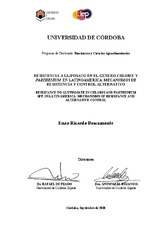Resistencia a glifosato en el género Chloris y Parthenium en Latinoamérica. Mecanismos de resistencia y control alternativo
Resistance to glyphosate in Chloris and Parthenium spp. in Latin America. Mechanisms of resistance and alternative control
Autor
Bracamonte, Enzo Ricardo
Director/es
Prado Amián, Rafael deRojano Delgado, Antonia M.
Editor
Universidad de Córdoba, UCOPressFecha
2018Materia
Malas hierbasParthenium hysterophorus
Chloris
Mecanismos de resistencia
Resistencia a herbicidas
Herbicidas
Glifosato
América Latina
METS:
Mostrar el registro METSPREMIS:
Mostrar el registro PREMISMetadatos
Mostrar el registro completo del ítemResumen
La incidencia nociva de las malas hierbas constituye uno de los mayores obstáculos para
alcanzar producciones agrícolas sustentables, produciendo pérdidas de hasta el 10% y
más del 30% de las cosechas en los países desarrollados y en desarrollo,
respectivamente. El control de malezas mediante el uso predominante de herbicidas
produjo la aparición y difusión exponencial de biotipos tolerantes y resistentes a las
principales familias químicas utilizadas. En Latinoamérica desde hace casi 40 años, las
poblaciones de malas hierbas están bajo presión de selección continua por el uso de
glifosato. Entre las especies que están incrementado en forma significativa su presencia
en esta región podemos citar a Parthenium hysterophorus L y el género Chloris.
Parthenium hysterophorus L. (Asteraceae, Heliantheae), es una planta herbácea anual o
de corta duración nativa de la región del Golfo de México. Es considerada una de las
peores malezas debido a su capacidad de invasión, potencial de propagación, impacto
económico y sobre la salud humana y el ambiente. Debido a su alto potencial de invadir
y perpetuarse sobre suelo no disturbados torna a Parthenium hysterophorus como una
seria amenaza en sistemas agrícolas con grandes superficies bajo siembra directa como
Brasil y Argentina. Dentro del género Chloris existen al menos 60 especies en
Latinoamerica, incluyendo al género Trichloris y otras especies de la tribu de las
Chlorideas. Estas especies aumentaron considerablemente su difusión en cultivos
perennes, entre ellos los frutales cítricos con amplio uso del herbicida glifosato y en
países con amplia adopción del sistema tecnológico siembra directa-soja RR (Roundup
Ready)-glifosato, como Brasil y Argentina. Estos sistemas productivos propiciaron el
aumento de la presión de selección y por ello, la difusión de biotipos resistentes a este
principio activo como Chloris barbata, Chloris elata y Chloris virgata. Estas especies
no son homogéneas en cuanto su distribución geográfica, taxonomia ni en su respuesta a
herbicidas. Esta situación complica significativamente su estudio y su manejo con
alternativas de control eficientes y homogéneas. Por ello, la caracterización morfológica
mediante estudios de diferenciación de especies y la determinación de los mecanismos
de resistencia al herbicida glifosato constituyen herramientas imprescindibles para
poder establecer estrategias de manejo eficientes, integradas y sustentables de
Parthenium hysterophorus L y de especies de Chloris presentes en áreas agrícolas de
Latinoamérica. En relación a lo anteriormente descripto es que se plantea la
justificación del este trabajo de investigación y los objetivos propuestos. The harmful incidence of weeds is one of the biggest obstacles to achieving sustainable
agricultural production, producing losses of up to 10% and more than 30% of the
harvests in developed and developing countries, respectively. The control of weeds by
the predominant use of herbicides produced the appearance and exponential diffusion of
tolerant and resistant biotypes to the main chemical families used. In Latin America for
almost 40 years, weed populations are under constant selection pressure due to the use
of glyphosate. Among the species that are significantly increased their presence in this
region we can mention Parthenium hysterophorus L and the genus Chloris. Parthenium
hysterophorus L. (Asteraceae, Heliantheae), is an annual or short-lived herbaceous plant
native to the Gulf of Mexico region. It is considered one of the worst weeds due to its
ability to invade, potential for propagation, economic impact and on human health and
the environment. Due to its high potential to invade and perpetuate on undisturbed soil
makes Parthenium hysterophorus a serious threat in agricultural systems with large
areas under direct seeding such as Brazil and Argentina. Within the genus Chloris there
are at least 60 species in Latin America, including the genus Trichloris and other
species of the Chlorideas tribe. These species increased considerably their diffusion in
perennial crops, among them the citrus fruit trees with ample use of the herbicide
glyphosate and in countries with wide adoption of the direct-soybean RR (Roundup
Ready) -glyphosate technology package, such as Brazil and Argentina. These
productive systems favored the increase of selection pressure and, therefore, the
diffusion of biotypes resistant to this active principle such as Chloris barbata, Chloris
elata and Chloris virgata. These species are not homogenous in terms of their
geographical distribution, taxonomy or in their response to herbicides. This situation
significantly complicates its study and its management with efficient and homogeneous
control alternatives. Therefore, the morphological characterization through studies of
species differentiation and the determination of glyphosate herbicide resistance
mechanisms are essential tools to establish efficient, integrated and sustainable
management strategies of Parthenium hysterophorus L and Chloris species present in
agricultural areas of Latin America. In relation to the previously described is that the
rationale of this research work and the objectives proposed.

